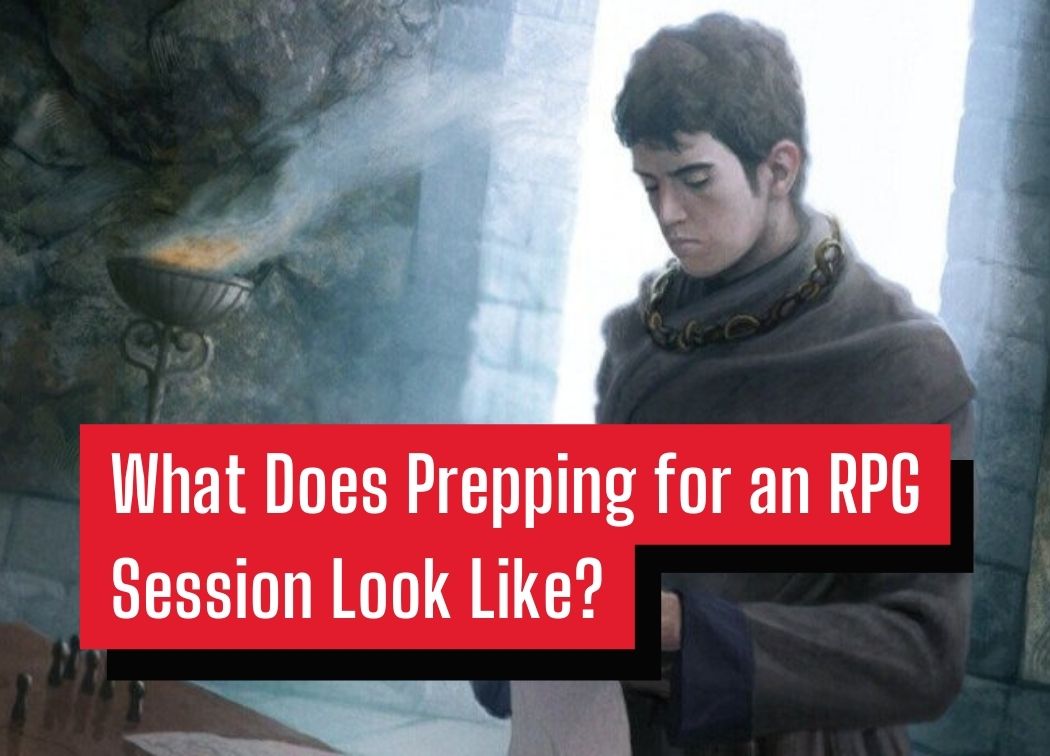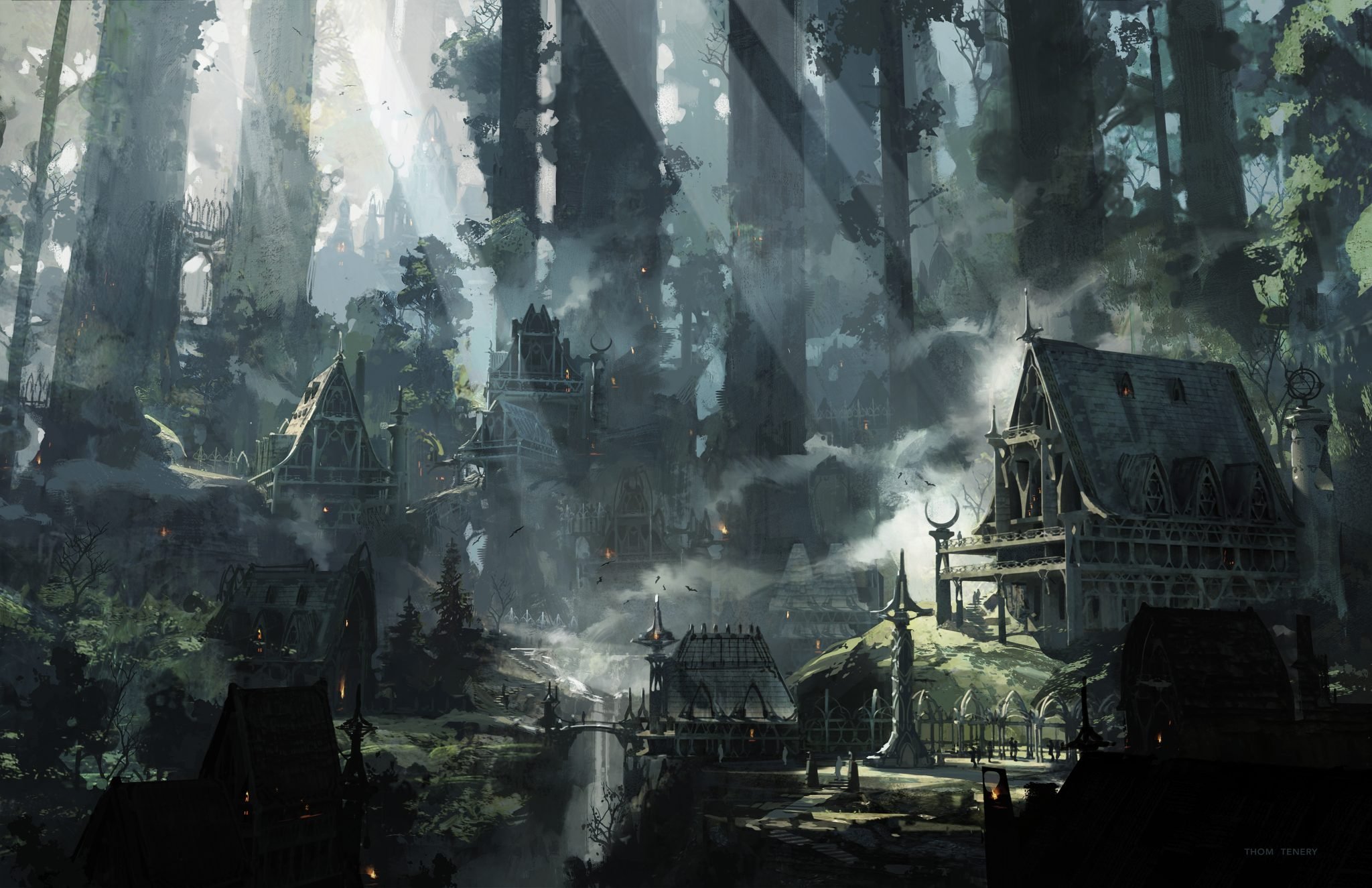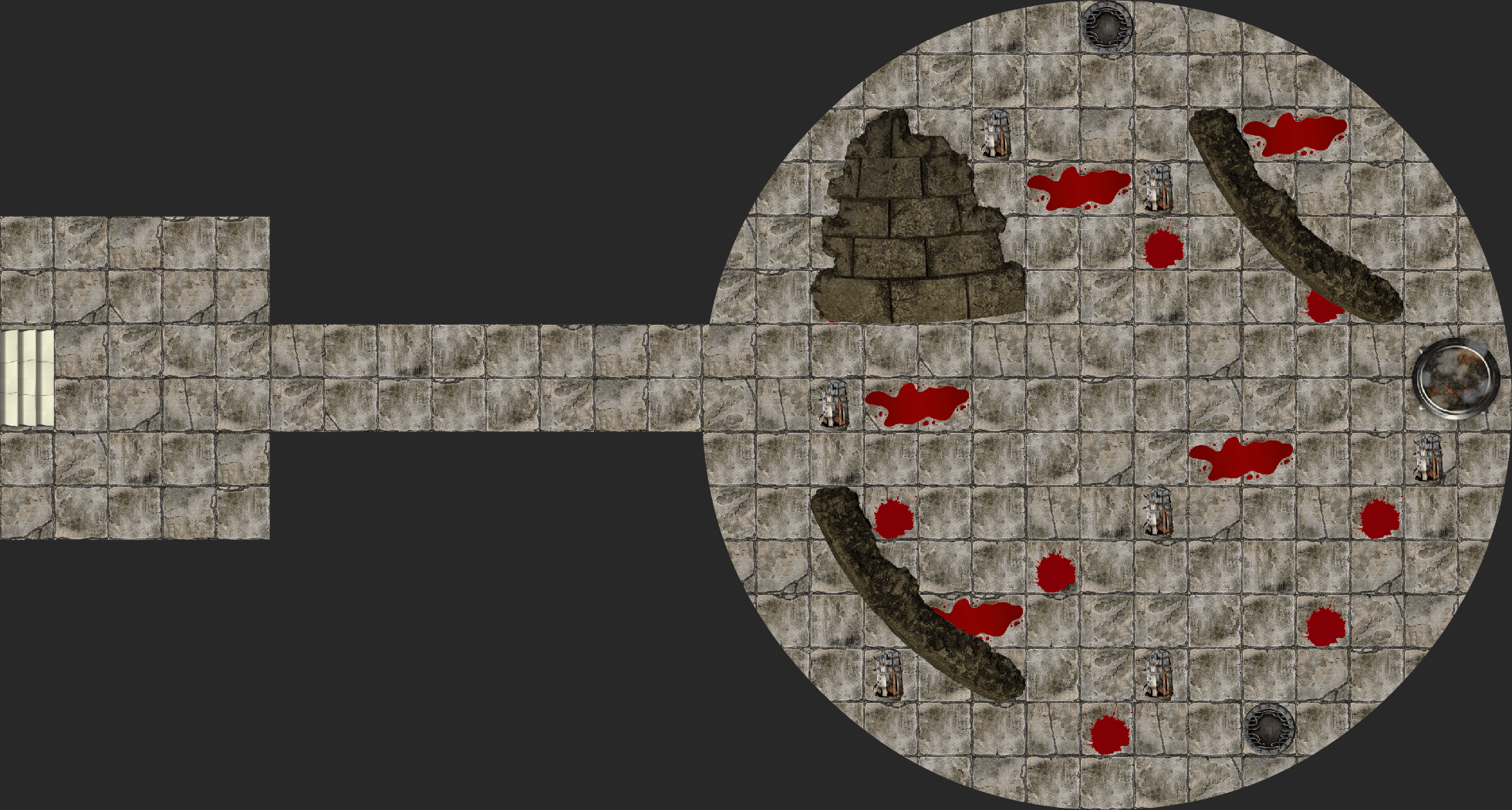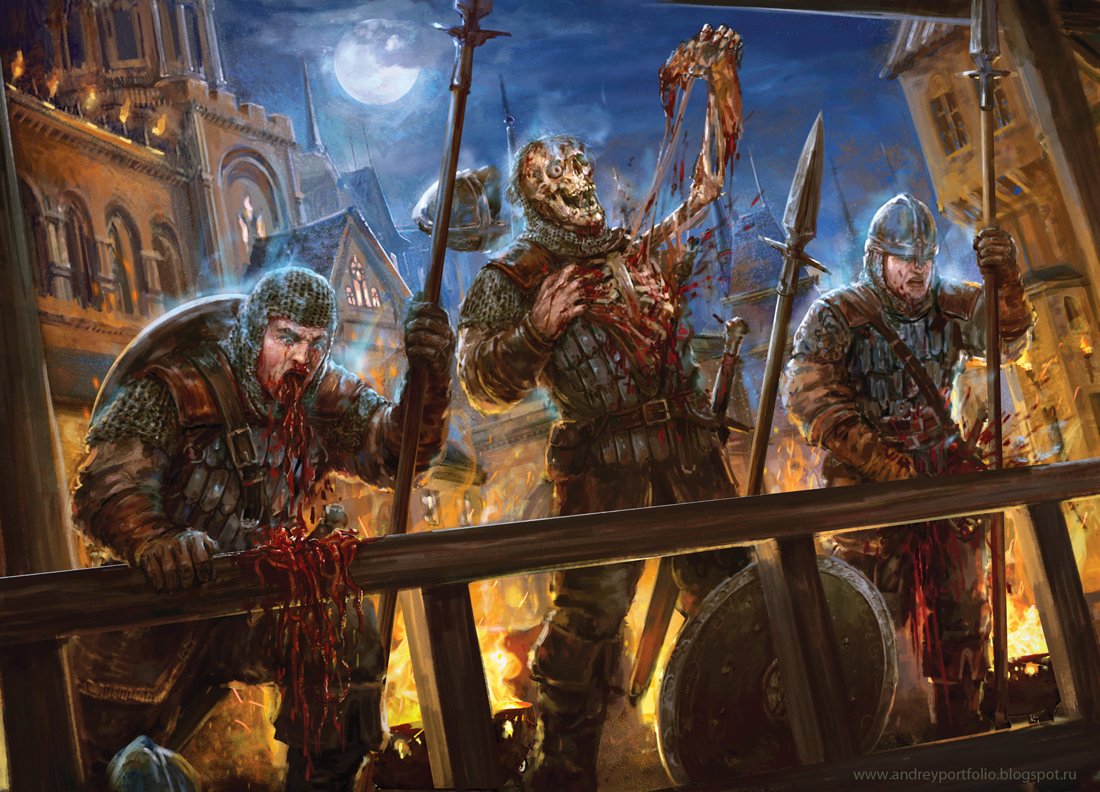What Does Prepping for an RPG Session Look Like?

I see a lot of people online talk about how they don’t prep for the games they GM/DM. They show up to to the session and just improvise! Well, allegedly anyway. Many times they go on to note that they bring some rough notes or index cards with info. But that’s prep, isn’t it?
I’ve written about how much time you should spend prepping an RPG session before. Obviously, this varies from system to system, but my estimate and my prep habits indicate that you should spend around 1/2 of a session’s worth of time prepping. Sometimes it’ll be more, others it’ll be less. It depends.
What irks me about this “I don’t prep” mentality is that 1) I don’t believe it at all and 2) it sets unrealistic expectations for new players. I don’t think these people are lying when they say that they don’t do any prep. What I do think, though, is that they’re categorizing prep work only as “writing stuff down”.
The writing is only a small part of prep work. Thinking about the next session? That’s prep. Come up with a cool new NPC? That’s prep.
Keep in mind that I’m approaching this from the perspective of prepping for games that have a lot of mechanics. Think D&D and not Honey Heist.
With that, we’re ready to dive in. What is RPG session prep and what can it look like?
Learning the RPG System
This should be an obvious one. Reading the book, googling questions, or even watching videos to get a taste of the system are all ways to learn how to play an RPG. I consider this as part of your initial prep to begin a campaign or run a game.
You need to learn the system before you play it. You don’t need to memorize or master it, but you should have a solid idea of how to play. Learning the RPG system you’ll be GMing and/or playing is an investment. It’s a big timesink, but it’s all done upfront and won’t be a part of your weekly prep.
However, you may find yourself going back to refresh yourself on rarely-used mechanics, relevant special cases, or rules you just flat-out don’t remember for an upcoming session. This is when I would put “Learning the RPG System” into the “RPG Session Prep” bucket.

Reading the Adventure Module
If you’re running an adventure module instead of creating your own game you’re certainly saving yourself a lot of time. Everything has already been written and drawn-out for you. There’s nothing wrong with this for the record, but I find that this is a big draw for people who opt to use premade modules.
That being said, there’s still prep work to be done on your end!
First of all, you should read the module cover-to-cover before you even start playing through it. Next, I’d recommend reading what you think your players could get into during their next session before you start the game up. A refresher is always nice.
Even further, modules aren’t railroads. The writers can’t think of every scenario your players may come up with. If they go off-track or look into something that the writers didn’t put much detail into, it’s up to you to start fleshing-out those areas.
Worldbuilding
I read somewhere that worldbuilding is for the enjoyment of the DM and not the players. At first, I thought this was ridiculous, but after thinking about it I totally agree.
Your players may care about the world you’ve created or are using, but generally not nearly as much about their characters, their adventures, and their surroundings.
Worldbuilding is something you can spend a ton of time on. You can create your world, write a whole timeline full of important events, and meticulously detail every culture or religion’s beliefs, mannerisms, and histories. But a lot of that is going to be wasted or barely used.
If you’re doing major worldbuilding, it’s prep, but it’s prep that you should assume is done for your personal enjoyment.
Creating NPCs
NPC creation is a part of worldbuilding, and it’s one that your players are sure to fully appreciate. They want to interact with the world, the NPCs are the vessel through which they do so.
I like to keep NPCs simple for the most part. I’ll write down a list of names or use a random name generator to give myself a list of names for random NPCs. Take this list and either improvise their descriptions or write yourself a couple of words per name to give yourself an outline to use in-game.
The more important NPCs take a bit more work. These are NPCs that the party will frequently interact with or have an important purpose in your game. For example, an innkeeper. That being said, I tend to keep their descriptions to just an index card with the majority of it consists of bullet points.
Villians are possibly the most important type of NPC that your players will frequently interact with. They give your players a reason to band together and fight. A villain may even take something important from the party. A good villain that the party can come together to hate can be challenging to create but is well worth the time investment.
It doesn’t take a ton of time or energy to whip up a quick list of NPCs to populate part of your world, but it’s certainly prep.
Writing Plot Hooks
I prep plot hooks in a similar way to how I prep NPCs. I’ll write a bunch down as I create a city or town, but I’ll keep most of them short and sweet.
Some plot hooks end up really piquing my interest or they are something that the party is angling towards anyways. Those ones I’ll spend a bit more time on and begin brainstorming proper encounters around them.
Many of your plot hooks will go unresolved. That’s the nature of a game that allows the characters to do anything. Unresolved plot hooks aren’t wasted prep time though, you can recycle them or even create other uses for them!
Again, this is easy and something you could think up as you daydream at work, but it’s time spent preparing for your game!
Planning (and Mapping) Cities, Towns, Villages, and Other Locations
My cities, towns, villages, and other important locations all live in word documents or notebooks. Whenever I create a world for a campaign I tend to draw a rough outline. I’ll then start to flesh-out these locations as the players draw closer to visiting them.
Make no mistake, these can be enormous areas full of NPCs, plot hooks, and worldbuilding. But you don’t necessarily have to plan everything down to a T. At the bare minimum, you should have a few important locations, a fistful of important NPCs, and a bunch of plot hooks to sprinkle about the area.

For some people, less is more, but I like to ride somewhere in the middle. I flesh out all the important locations a bit, but I don’t create say the inventory of each shop or the entire menu of a restaurant. I focus on the highlights, but the highlights still take time to figure out!
I use Inkarnate to do my location maps. I’m by no means even close to an expert mapmaker, but it’s fun to sit down once or twice throughout the campaign to create a few maps.
This is obviously prep, but it’s not something you’re going to have to bang-out on a weekly basis. It’s very much an investment where you sink a bit of time into it early on so you can slack off a bit for the weeks while your players are exploring your locations.
Designing and Balancing Encounters
I’m generally very hands-on when I make my own adventures. I select specific monsters and enemies, include certain traps, and even throw in some puzzles. Point being, I spend time creating encounters with my specific party and game in mind.
This takes a lot of time to do well, especially at first, but it’s one of my favorite parts about GMing. I get an idea in my head and then figure out how to make it spring to life using the game’s mechanics. It’s a fun puzzle for me.
One way to speed up encounter design and balance is to use a random encounter generator. Kobold Fight Club is my go-to for D&D 5e, but there are tons of random encounter tables and generators all over the internet for various game systems.
Not every room in your sprawling dungeon has to be created from the ground up. Dungeons and adventures have plenty of trash fights. In fact, you can save a lot of time by writing down a list of enemies that fit the theme of your adventure and having a random generator spit out some encounters for you.
However, encounter design is probably the first thing people think of when talking about prepping for a session of their RPG.
Creating Homebrew Creatures and Mechanics
Homebrewing is certainly not something that anyone has to do, though I’d encourage you to try it out. Well, once you understand the rules and mechanics of the system you’re playing of course.
Sometimes you have a cool idea that fits well with the game you’re playing, but for some reason, it hasn’t been made yet. Congratulations, you now have a reason to create your very own thing!
Figure out how you can create said thing while you make it as balanced and fun as possible. Then put the finishing touches on it and unleash it upon your gaming table. Fun, right? Absolutely! But it can take a lot of time and effort to make high-quality homebrew.
Even if you’re not creating your own homebrew, using it is still labor intensive. If a player comes to me with homebrew they’d like to use I read through it and make sure it’s well-made.
Homebrew means work. It’s fun work and frequently extremely appreciated by your players, but it’s work.
Inputting Creature Stats Into a Virtual Tabletop Program
Depending on the VTT you and your group use you may need to make sheets and macros for the creatures, monsters, and enemies you may use in your session.
Some VTTs such as Roll20 (which I use) let you purchase books or sets of premade creature sheets so you don’t have to spend the time putting them in your game. The downside to this is that a) it costs money, and b) this option tends to be reserved only for the more popular RPGs.
Tedious bookkeeping like porting over creatures is prep, and it’s generally not the fun kind!
Making Battlemaps
You don’t need a full set of Dwarven Forge tiles to make a battlemap. When my friends and I were able to play in-person we’d use beer bottle caps as tokens and a giant piece of grid paper with a hand-drawn map of the battlefield on it. There are many ways to use a battlemap.
But it does take some time to make them. Maybe you draw the battlemap as combat breaks-out and the players roll initiative. That’s possible to do. I wager you still have a rough sketch or a completed version of your map before you jump into combat though.

Maybe you use a random generator like Donjon to generate your maps to save some time. Regardless, it’s still prep for your RPG session even if it only takes a few minutes here and there.
I’m a very visually-oriented person. I can do short forays into theater of the mind style combat, but I find myself getting frustrated with it. While playing without battlemaps or visuals would significantly cut down my prep time, it would also lessen my enjoyment of the game.
I’ve been using Dungeon Painter Studio to make my maps, but I’ve also been compiling a Pinterest board full of maps to use in my games. I also play online though, so these types of detailed battlemaps make more sense in that format.
Drawing maps is prep. Thinking of what elements to include in a map is prep.
Battlemaps for Online Games
You’re not required to make a battlemap for an online game. However, I’ve found that for games like D&D 5e, it’s extremely helpful to have.
Theater of the mind can certainly work in online games. But you’re not there to gauge the players’ body language or facial expression. You have less information to pick up on if the players are confused by your descriptions or narrations. You also don’t have your own body language to convey your thoughts.
I find battlemaps, even the most simplistic ones to be very helpful for me and the players’ understanding of combat encounters. If you’re not someone who can create maps on the fly, draw some out and import them to your VTT ahead of time, just as you would draw a paper map before the session.
I also go all-out and plaster my maps with dynamic lighting on Roll20 so that takes some extra time as well.
Creating the Ambiance
Ambiance can be made by finding or making pictures to show to the players to convey a feeling. It could be selecting the best music to set the tone of the fight or location. It could be creating props or handouts to give to the players.
Ambiance is something that isn’t brought up a lot, but it can be a very powerful tool that the GM can use to help convey the setting and immerse the players. It’s also time-consuming to prepare.

That being said, selecting the music for my games is one of my favorite parts about GMing. It doesn’t feel like prep work to me when I spend some time making a playlist. But it is. Prep work doesn’t have to be boring or tedious to be considered prep work, it can be a fun activity by itself.
Conclusions
I’ve certainly beaten this strawman to death by now. But this seriously has to be one of my biggest pet peeves that I’ve seen crop up in a lot of discussions about GMing and RPG session prep.
Prep doesn’t have to be a tome of highly detailed notes, colorful maps, and a playlist of carefully curated music. Though it certainly can be. Prep can just be a few index cards and a couple of sticky notes in the relevant pages of your books.
I believe that it’s deceitful to tell someone new to the hobby that you don’t prep at all for your sessions, especially if you’re an experienced GM. You’re setting a new GM up with expectations that they can do what you do with very little time/effort when that’s generally not the case.
I think a better discussion about prep would be to talk about what is smart to prep. A lot of the things I listed in this article can absolutely be skipped. Point-out the unnecessary timesinks and pitfalls that don’t pay off for efficient prep work. Other GMs can learn from this to streamline their prep if they wish to cut down on it.
Everyone does prep work before their next session. Prep time isn’t the time spent pen-to-paper planning a session, prep time is many different things for different people.
